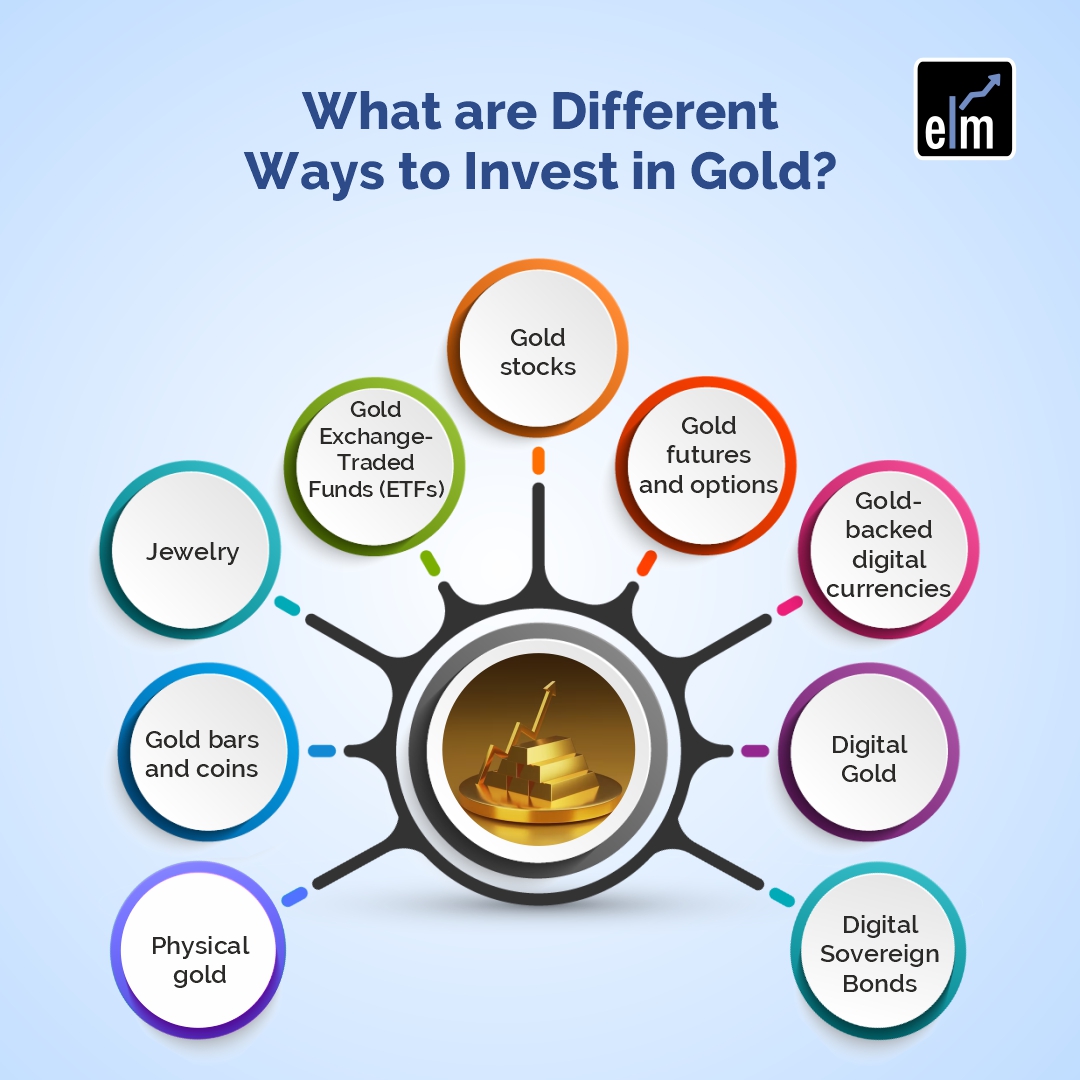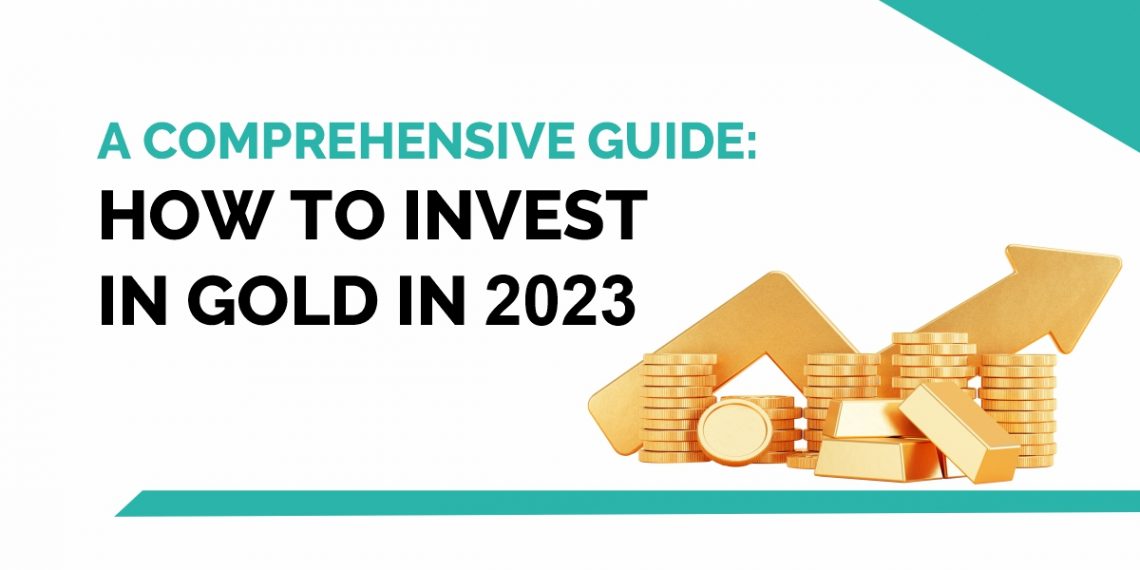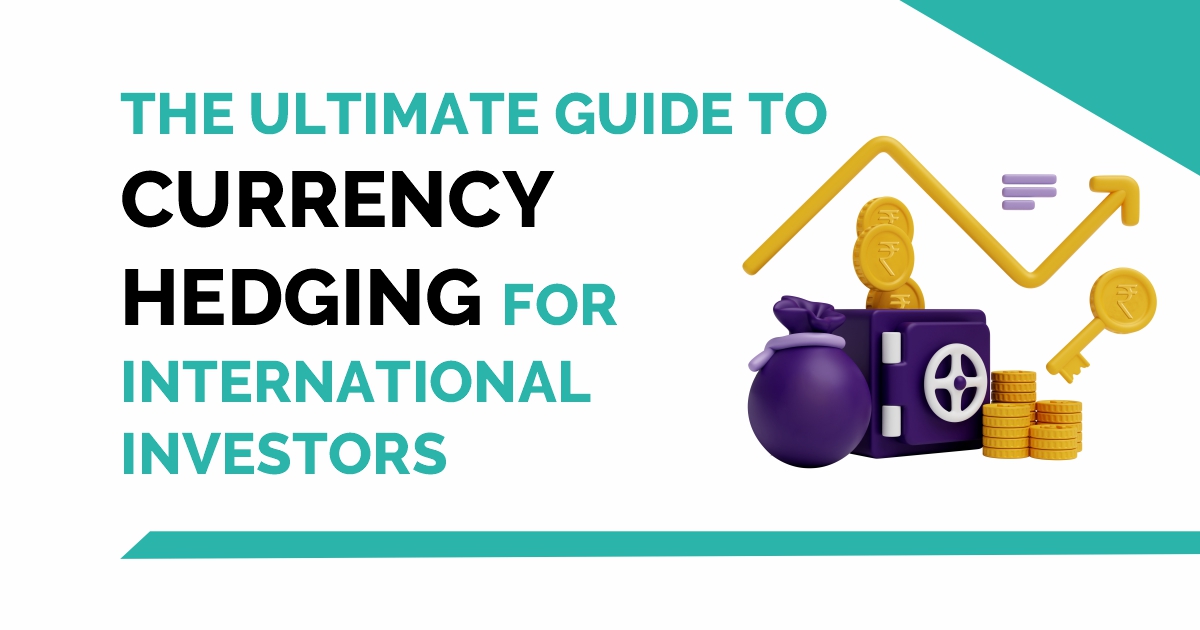Investing in Gold has long been considered a safe haven investment and a means of securing one’s financial future. Indians now regard gold as an investment to diversify their portfolio as opposed to only a physical asset as a result of the financial market’s evolution.
For a gold investment strategy, investors might search for minimal transaction fees and taxes, a large investment amount, investment flexibility, and significant returns without sacrificing liquidity.
Gold is considered to be one of the most precious investments in India because of some influencing factors such as inflation beating capacity and high liquidity.
Investors wishing to buy gold directly often have three alternatives: they can buy the actual item, buy shares of an exchange-traded fund (ETF) that tracks the price of gold, or trade futures and options on the commodities market. For instance, novice investors might purchase gold coins while experienced investors employ tactics using options on gold futures.
In today’s blog let us discuss why one should invest in Gold, what are the ways to invest in Gold and how should one trade in Gold:
Table of Contents
What do you mean by Gold Investment?
One of the most popular investments in India is gold. Its strong selling advantages include high liquidity and the ability to overcome inflation, in addition to charm, prestige, and other qualities. When the markets are turbulent, gold prices soar.
Even if there are times when gold prices fall in the markets, these periods are brief, and gold prices always make a robust recovery.
Investing in Gold can be done in various ways, however before we get into a gold investment, let us discuss reasons for investing in Gold:
Why should one consider investing in gold?
A well-diversified portfolio should include gold as a strategic long-term investment and as a foundational allocation. By keeping a long-term allocation and taking advantage of gold’s role as a safe haven during times of economic turmoil, investors have been able to recognize a significant portion of gold’s value over time.
1. Portfolio diversification
Effective diversifiers might be challenging to come by. As market volatility and uncertainty increase, many assets become more and more connected as a result of risk-on/risk-off investing decisions. As a result, many ‘diversifiers’ fall short of safeguarding portfolios when investors most need them.
The difference between gold and other risk assets is that as these assets decline, gold’s negative correlation to them grows.
For instance, gold would fare well if the equities markets started to decline. The overall volatility of your investment portfolio will be lowered if you include gold as an investment option.
One can see from the chart above when the Nifty 50 falls down, Gold rises and vice versa. Thus when the equities will go down, Gold Investment will help in the hedging of the portfolio.
2. A long-term source for Return
Gold has always been seen by investors as a valuable asset during times of ambiguity. However, historically, it has produced long-term gains in both prosperous and difficult economic times. Due to the variety of its sources of demand, gold is particularly resilient and has the potential to generate positive returns under a variety of market circumstances.
On the one hand, gold is frequently used as an investment to safeguard and grow wealth through time, but on the other side, it is also a consumer commodity due to the demand for jewellery and technology.
The need for countercyclical investments during uncertain economic times is what raises the price of gold. Pro-cyclical consumer demand helps the economy perform well when it is growing. Together, these elements provide gold the capacity to offer stability in a variety of economic contexts.
3. Liquidity
Additionally, the gold market is more liquid than a number of other significant financial markets, such as the euro/yen and the Dow Jones Industrial Average, while primary dealers’ trading volumes are comparable to those of US 1-3 year treasuries and US T-Bills.
Large, buy-and-hold institutional investors can easily be accommodated due to the size and depth of the market. In sharp contrast to many financial markets, gold’s liquidity persists even during difficult economic times.
Another significant benefit of gold is that it enables investors to pay obligations when less liquid assets in their portfolio are hard to sell or are overpriced.
These are the reasons why should one invest in gold, now let us discuss how we can invest in gold:
What are Different Ways to Invest in Gold?
How does one invest in gold? is the ‘golden question’ in this situation. In the past, it was done by purchasing actual gold coins, bullion, relics, or jewellery. However, there are more recent types of gold investments available today, such as gold mutual funds and gold exchange-traded funds (ETFs).
Investing in gold ETFs is akin to spending the same amount on actual gold but without the burden of needing to keep it. Since the gold is kept in Demat (paper) form, there is no chance of theft or burglary. Investing in gold mining firms is done through gold funds.
Let’s examine various ways to Invest in Gold:

1. Physical Gold
Purchasing investment bars and coins from a bank or reputable dealer is one of the easiest methods to obtain gold as an investment. Investors must take care of shipping, storage, and insurance as well as paying a premium over the current gold price when purchasing gold in various forms.
Over the past ten years, demand for small bars and coins has made up around two-thirds of the yearly demand for gold as an investment and about a quarter of the overall demand.
Governments generally issue investment gold coins, also referred to as bullion coins, and they have a face value. They come in a variety of shapes, but their worth stems from the amount of gold they contain, which is normally between 91.67% (22 carats) and 99.99% (24 carats).
In addition to 1, 10, 100, and 400 troy ounces, investment gold bars are available in denominations of 1, 10, 20, 50, 100, and 1,000 grammes. These bars have a purity of between 99.5% and 99.99% and are produced by manufacturers who have received industry accreditation. The London Good Delivery (LGD) bar, which is used for clearing in London and measures about 400 troy ounces, is frequently utilised by large institutions.
2. Gold Exchange-Traded Funds (ETFs)
Exchange-traded investment vehicles that invest in gold bullion include exchange-traded funds (ETFs) with physical backing, exchange-traded commodities (ETCs), and comparable goods. About one-third of the demand for gold as an investment comes from them.
Similar to stock in a company, shares in physical gold ETFs can be purchased and sold on exchanges. Individual and institutional investors can buy physical gold ETFs, and the price typically follows the performance of the underlying gold spot market.
With the ease of a contemporary investment product, physical gold ETFs give investors access to gold as an asset class. Customers who purchase shares in ETFs do not need to physically trade real gold or oversee the storage of their holdings; instead, they can do so as swiftly and easily as they would purchase shares in publicly traded corporations.
Some of the best Gold ETFs in India include:
| Name | Market Cap (Rs. in cr.) | Close Price (Rs.) | 5Y CAGR (%) | Expense Ratio |
| IDBI Gold Exchange Traded Fund | 95.12 | 5,232.85 | 13.16 | 0.35 |
| Axis Gold ETF | 319.17 | 48.89 | 13.16 | 0.53 |
| Kotak Gold ETF | 1,984.14 | 48.99 | 13.12 | 0.55 |
| Invesco India Gold Exchange Traded Fund | 74.22 | 5,063.75 | 12.99 | 0.55 |
| ICICI Prudential Gold ETF | 1,905.05 | 50.16 | 12.84 | 0.5 |
3. Gold Stocks
Stocks of businesses engaged in gold exploration, mining, refining, or marketing are referred to as gold stocks. Without actually owning any gold, investing in gold stocks can provide you access to the metal’s price.
The supply and demand of gold, geopolitical developments, and economic conditions are just a few examples of the variables that might affect the value of the greatest gold stocks.
Below are the best gold stocks to invest in India–
4. Gold Futures and Options
Gold futures contracts are available through the NSE, BSE, and Multi Commodity Exchange (MCX) in India. Businesses involved in the production and trade of gold frequently utilise it as a hedge against price risk.
The exchanges also offer fold futures in small-scale denominations to meet the needs of every investor. Trading can be difficult, even for experienced investors who are well-versed in derivatives. You can buy and sell gold at a future time by using a gold futures contract. On the date of maturity, the gold contract is settled, but the value will be determined at the time of the transaction.
Along with the contract’s pricing, investors must also pay various brokerage, regulatory, and exchange fees. The NSE and BSE only offer contracts with a minimum weight of 100 grammes, but MCX offers a variety of contracts with weights ranging from 1 grammes to 100 grammes. Investors should review the contract’s details to determine the premium payment amount due.
5. Gold-Backed Digital Currencies
A cryptocurrency with gold backing is a derivative digital asset whose value is guaranteed by the price of gold at the time it was created. Each gold-backed cryptocurrency stipulates that each of its tokens is equivalent to a certain weight or number of Troy ounces of gold.
This implies that there should be an equivalent quantity of gold in reserves or that there is a problem with the business or trusted custodian rather than tangible collateralized assets. Even gold can be redeemed for some tokens. They differ from other crypto in that they are linked to a physical asset, shielding it from sharp price fluctuations.
6. Digital Gold
Digital gold is an additional investment choice. This was released by the Swiss bullion brand PAMP in collaboration with the Metals and Minerals Trading Corporation of India (MMTC). On your smartphone, you may easily purchase gold using digital wallet systems.
The gold you purchase is kept secure in a vault under MMTC-PAMP’s watchful eye. You have five years to store the gold safely and can accept delivery at any moment during that time. Gold can be purchased as bars or coins in a variety of denominations. The pricing is open and based on rates found on the world market.
7. Gold Sovereign Bond
The Sovereign Gold Bond (SGB) Scheme was launched by the Indian government in November 2015 as a substitute for physical gold investments. The market has seen a significant fall in the demand for physical gold over time. SGBs keep track of the asset’s export-import value while also ensuring transparency.
Government securities known as SGBs are regarded as secure. They are valued in multiples of a gramme of gold. SGBs have seen a sharp rise in investors because they are seen as a viable alternative to actual gold.
You only need to speak with a SEBI-authorized agent or broker if you want to buy an SGB. The corpus (based on the bond’s current market value) will become available whenever you redeem the bond.
You can think about diversifying your portfolio by holding 5% to 10% or more gold. It is ideal for those who have a low appetite for risk because it is a low-risk investment. SGBs are much more affordable to buy or sell than actual gold. In comparison to the cost of buying or selling actual gold, the SGB is also inexpensive.
SGBs are another option for those who don’t want to deal with the difficulties of storing actual gold. This is because it is simple to store these in Demat form, and since they are in electronic form, no one can take them.
According to the RBI circular, the next forthcoming SGB issue would take place between September 11 and September 15, 2023. The issue date is September 20, 2023.
What are the Benefits and Risks of Gold Investment?
Below are the benefits and risks of investing in Gold:
- Inflation Hedge– Purchasing power declines as prices rise as a result of inflation. Consequently, if you have cash, you are in fact losing money. On the other hand, gold is frequently regarded as an inflation hedge. Gold’s worth could rise when the value of the dollar declines. Although not everyone concurs and gold may not always increase when inflation does, inflation may still be a factor in investments.
- Portfolio Diversification- Some investors purchase silver, gold, or both in order to diversify their holdings. Spreading your money among many investment types, as opposed to having it fully invested in one asset class, may enable you to more effectively balance risk and return.
- Save Haven- Considering that the price of gold may increase during these times, purchasing it may be able to assist investors in getting through uncertain economic times.
Below are the risks of investing in Gold:
- Complexity- It can take some time to catch up if you are unfamiliar with gold and the entire asset class of precious metals. It’s not enough to decide which asset class you think will increase in value more than conventional stocks and bonds in order to choose it. Risk, cash flow, taxes, and other factors must also be taken into account. Therefore, you should be aware that including this asset type in your portfolio could make your investment decisions more complex.
- Possibility of performance lag with time- Gold may outperform other investments temporarily but may not be as resilient to long-term price growth. For instance, if you’re attempting to save for retirement, investing too much in gold may prevent you from making the long-term gains that you would have made by investing in stocks or bonds. The proper allocation must be made for this reason.
What are the Factors Affecting Gold Prices?
Before we get into investing in gold, there are some factors that we should know that affect gold prices-
1. Inflation
Gold prices can be significantly impacted by inflation, which is the rise in the cost of goods and services. The price of gold typically changes in direct proportion to inflation, meaning that higher levels of inflation typically cause high gold prices since the value of money decreases.
This is due to the fact that during times of inflation, individuals typically prefer to store wealth in the form of gold, as gold’s value is thought to be stable over the long term, increasing demand. As a result, gold also serves as a tool for inflation hedging.
2. Interest Rates
Under normal circumstances, interest rates and gold prices have historically had an inverse relationship; with rising interest rates, people typically prefer selling gold to make more money. However, as the interest rate falls, more people choose to purchase gold, driving up both its demand and price.
3. Government Reserves
The Reserve Bank of India, along with the central banks of the majority of other nations, keeps gold reserves alongside their currency. When the RBI starts purchasing more gold than it is selling, the price of gold rises. This is because there is a shortage of gold and the market is experiencing an increase in cash flow.
4. Geo-Political Factors
Given that India is one of the biggest users of gold, any change in the price of gold on the international market will impact its price in India.
Additionally, investors view gold as a safe haven during times of political unpredictability or geopolitical unrest, which raises demand for it and consequently its price.
The demand for gold tends to increase during such crises, making it a crisis commodity for parking funds. In contrast, other asset classes would often see a decline in their value during such crises.
What are Taxation and Regulations for Gold Investment?
Below are the taxes on different types of Gold Investment-
1. Income Tax on Physical Gold
Physical gold investments include gold in the shape of jewellery, bars, coins, or biscuits. The tax regulations for the sale of actual gold are listed below.
- Tax Rate – The taxpayer must pay income tax at slab rates on STCG and 20% with indexation on LTCG.
- ·Income Head: Capital Gains are reported as income when physical gold is sold. It is a Long Term Capital Gain (LTCG) if the taxpayer sells physical gold after keeping it for longer than three years. It is a Short Term Capital Gain (STCG) if the taxpayer sells physical gold after owning it for less than three years.
2. Income Tax on Gold Mutual Funds and ETFs
- Income Head – Income from capital gains is income from the selling of gold mutual funds or gold ETFs. It is a Long Term Capital Gain (LTCG) if the taxpayer sells gold mutual funds or ETFs after owning them for more than three years. A short-term capital gain (STCG) occurs when a taxpayer sells gold mutual funds or exchange-traded funds (ETFs) after owning them for less than three years.
- Tax Rate – With the advantage of indexation, the taxpayer should pay income tax at slab rates on STCG and 20% on LTCG.
3. Income Tax on Sovereign Gold Bonds (SGBs)
- Sovereign Gold Bond interest is taxed at slab rates as an IFOS income.
- Income from the selling of SGB after eight years is not subject to tax.
- Long Term Capital Gains are earned on the sale of SGB after 5 years but before to the end of 8 years, and they are taxed at 20% with the advantage of indexation.
- Additionally, the tax rate on income from the sale of SGB is 10% without the benefit of indexation if the sale occurs after a year but before five years.
- Short-term capital gains are earned through the sale of SGB within a year, and tax is due at slab rates.
4. Income Tax on Digital Gold
- Sales of digital gold generate income from capital gains under the Income Head category. It is a Long Term Capital Gain (LTCG) if the taxpayer sells digital gold after owning it for longer than three years. It is a Short Term Capital Gain (STCG) if the taxpayer sells digital gold after owning it for less than three years.
- Tax Rate – With the advantage of indexation, the taxpayer should pay income tax at slab rates on STCG and 20% on LTCG.
5. Income Tax on Gold Derivatives
- Profit – Profit on the selling of derivatives relating to gold is a Non-Speculative Business Profit. By creating a P&L account, the taxpayer can deduct expenses from such income and calculate their taxable profit or loss.
- Tax Rate: Slab rates apply to the taxation of non-speculative business income.
You can also do our course on Commodity Markets Made Easy
Bottomline
One of the more popular investment possibilities in India is gold, which is regarded as a significant monetary asset. In uncertain times like geopolitical upheaval or international trade wars, investors often turn to gold as a safe haven. However, there are many other factors that affect gold prices in the nation, including inflation, interest rates, and the rupee-dollar equation.
Frequently Asked Questions (FAQs)
Is it good idea to invest in gold?
Due to its potential for having a lower correlation with other assets like stocks or bonds, gold is frequently regarded as a suitable investment for diversification.
What is the best thing to invest in gold?
It is among the best methods for buying gold. There are numerous gold schemes available on the market, which are primarily floated by jewellers. These programmes function similarly to SIPs, where you make a set monthly deposit at a jeweller. The programme may last for 11 months, two years, or longer.
How to invest in gold for beginners?
Exchange-traded funds (ETFs) for gold are a well-liked alternative for new investors to get started with gold. You may gain exposure to gold and diversify your portfolio by using ETFs that only own gold mining firms.
Is gold a good 10 year investment?
Over the past three years, gold has returned 18%, over the past five years, 54%, and over the past ten years, 41%.






